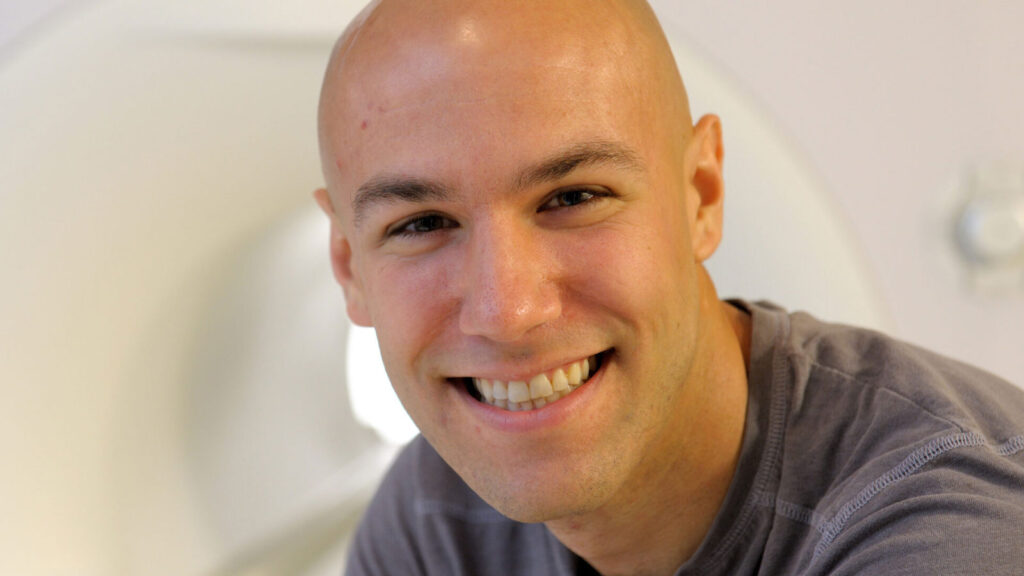NUNM postdoctoral investigator focuses on prevention as the best way to tackle Alzheimer’s disease.

With the National University of Natural Medicine (NUNM) gearing up to host Research Week from April 29 to May 3, we’re shining a spotlight on the work of our researchers.
Ben Zimmerman, Ph.D.
Postdoctoral Research Investigator, Helfgott Research Institute, NIH-funded BRIDG R90
Hometown: Mokena, Illinois
What are your research interests and how did you get there?
My research interests are around improving brain vascular function in aging, and in understanding the interplay between the brain’s vascular health and cognitive function.
I was fascinated with the brain from a pretty young age and in undergrad, I followed a mostly pre-med educational path to practice neurology. However, I had the opportunity to do research in a virology lab at Baylor College of Medicine that was such a deeply enriching and pleasurable experience that I decided to pursue a career in research. I interviewed and chose the University of Illinois at Urbana-Champaign because they had an amazing research institute, called the Beckman Institute, which was specifically designed to foster interdisciplinary collaborations – and I loved that the environment was cooperative instead of competitive and that you had so much opportunity to work on a wide variety of projects. At the time, the neuroscience program was fairly unique in a way that appealed to me, in that there were no rotations across labs (which is typical in a lot of Ph.D. programs) and no set coursework. You just took whatever classes you needed to become the kind of researcher you wanted to be. But the interviews were also pretty intense, similar to speed dating, in which you had just a couple of days to match with the lab where you would go on to spend five plus years doing your research.
I hit it off with my graduate advisor, who did noninvasive optical imaging of the human brain. They were cognitive neuroscientists by training and were mostly using the tool to look at neural activity in different kinds of cognitive tasks. But they had this massive artifact that they were always trying to get rid of in all their data from the pressure wave of the heartbeat. But they had this incredible idea that maybe there was useful information in this “noise” signal and started looking to see if spatially localized differences in the shape of the pulse pressure wave from the brain arteries predicted anything. And it did!
At the time, there was still a lot of hype about the idea that exercise, especially aerobic exercise, seemed to be really good for brain health, but no one knew exactly why. So we were using this tool, along with some other measures of brain vascular function, to see if maybe improving the brain’s vascular function was mediating some of those benefits to cognition, and we built up a lot of evidence that suggested that it did. At the same time, the evidence started growing that there were vascular contributions to the pathology of Alzheimer’s disease, the most common form of dementia. This is actually an old idea, at least from the 1960s, but the idea lost steam under the wave of the amyloid hypothesis until recently. And now it is increasingly recognized that cerebral vascular dysfunction is one of the earliest predictors of the disease.
Vascular dysfunction is a phenomenal preventative therapeutic target. We have lots of different ways to measure it. Some of them are very cheap (like blood pressure). We also have lots of different ways to modify it, and some of those interventions are also very cheap (like walking or running). I became converted to the belief that prevention was the best way to tackle this disease, especially as pharmaceuticals became extremely effective at eliminating amyloid plaques and quite ineffective at curing Alzheimer’s disease.
How are your research interests manifesting?
At NUNM, I am studying the botanical herb, Centella asiatica — or gotu kola — for its potential to improve brain vascular function in aging.
What are the implications of your research?
I talked about vascular function as if it were one thing, but there are many features of anatomical structure and physiology that play a role in vascular function. Ideally, we would understand interventions that promote the health of all of those various components and be able to tailor comprehensive interventions to individuals.
So to understand the specific mechanisms at play, I am conducting studies in both mice and people to investigate the effects of gotu kola on different aspects of vascular function.
Why is NUNM a good place to do research?
NUNM is an ideal environment to carry out this research because:
1) There is an orientation toward the importance of prevention, whole-body health interactions, and individualized healthcare. You have a research community and often a patient/participant population that already “buys in” to this approach to healthcare, which I personally think is essential specifically for diseases of aging.
2) There is phenomenal clinical trial experience and support, especially for the size of the operation. Smaller-sized research institutions often have the advantage of being nimbler and making it easier to do research, but they usually suffer from lacking resources and expertise. However, NUNM has placed that expertise and the necessary resources in just the right places.
3) There are a lot of really strong collaborative relationships with larger institutions that do have more resources so that specialized equipment is available.